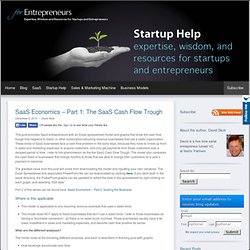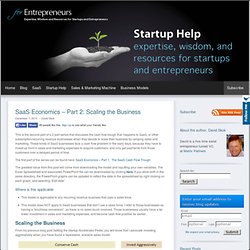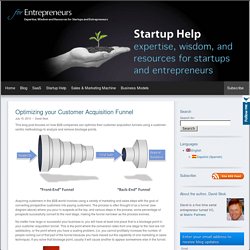

SaaS Metrics 2.0 – A Guide to Measuring and Improving what Matters. SaaS Economics - Part 1: The SaaS Cash Flow Trough. This post provides SaaS entrepreneurs with an Excel spreadsheet model and graphs that show the cash flow trough that happens to SaaS, or other subscription/recurring revenue businesses that use a sales organization.

These kinds of SaaS businesses face a cash flow problem in the early days, because they have to invest up front in sales and marketing expenses to acquire customers, and only get payments from those customers over a delayed period of time. I refer to this phenomenon as the the SaaS Cash Flow Trough. The model also compares the cash flows of businesses that charge monthly to those that are able to charge their customers for a year’s payment in advance. The greatest value from this post will come from downloading the model and inputting your own variables. The Excel Spreadsheet and associated PowerPoint file can be downloaded by clicking here.
SaaS Economics - Part 2: Scaling the Business. This is the second part of a 2 part series that discusses the cash flow trough that happens to SaaS, or other subscription/recurring revenue businesses when they decide to scale their business by ramping sales and marketing.

These kinds of SaaS businesses face a cash flow problem in the early days, because they have to invest up front in sales and marketing expenses to acquire customers, and only get payments from those customers over a delayed period of time. The first part of the series can be found here: SaaS Econonics – Part 1: The SaaS Cash Flow Trough. The greatest value from this post will come from downloading the model and inputting your own variables.
The Excel Spreadsheet and associated PowerPoint file can be downloaded by clicking here. If you store both in the same directory, the PowerPoint graphs can be updated to reflect the data in the spreadsheet by right clicking on each graph, and selecting “Edit data”. SaaS Metrics - A Guide to Measuring and Improving What Matters. This blog post looks at the high level goals of a SaaS business and drills down layer by layer to expose the key metrics that will help drive success.

Metrics for metric’s sake are not very useful. Instead the goal is to provide a detailed look at what management must focus on to drive a successful SaaS business. For each metric, we will also look at what is actionable. There is an updated (re-written) version of this post available here: SaaS Metrics 2.0. Before going any further, I would like to thank the management team at HubSpot, and Gail Goodman of Constant Contact, who sits on the HubSpot board. Let’s start by looking at the high level goals, and then drill down from there: Why Churn is SO critical to success in SaaS. Summary: Illustrates graphically why churn is a huge problem a SaaS company gets larger.

It also looks at a very surprising factor that can massively accelerate SaaS growth: negative churn. (This article is applicable to any recurring revenue business, not just SaaS.) Introduction As a SaaS company becomes larger, the size of the subscription base becomes large enough that any kind of churn against that base becomes a large number. That loss of revenue requires more and more bookings coming from new customers just to replace the churn.
The red and yellow lines show the lost revenue due to customers cancelling their subscriptions (churn). Looking at the graph above, we can see that Churn is really not that big of a number in the early startup months. The graph below shows the impact on Total MRR (monthly recurring revenue) of each scenario, which is fairly substantial. The Impact of Negative Churn The result is quite shocking. It’s an amazing result. How do you achieve Negative Churn? Multi-axis Pricing: a key tool for increasing SaaS revenue. Scalable pricing is a powerful tool to grow revenue in a SaaS or software business. It allows you to capture more of the revenue that your customers are willing to pay, without putting off smaller customers that are not able to pay high prices. It also provides a great way to continue to grow revenue from your existing customers.
This post looks at how to create scalable pricing using multiple pricing axes, and discusses the different types of axes that can be used. Introduction Many SaaS startups begin life with one product that has a simple pricing model. However as time progresses, they may hear comments like: “I would have been happy paying far more for your product as it provides such great value to me”“I didn’t consider your product as it was too cheap, and didn’t look like a credible option to handle our more advanced needs”“I only needed a subset of your functionality, and your product was too expensive”
Optimizing your Customer Acquisition Funnel. This blog post focuses on how B2B companies can optimize their customer acquisition funnels using a customer-centric methodology to analyze and remove blockage points.

Acquiring customers in the B2B world involves using a variety of marketing and sales steps with the goal of converting prospective customers into paying customers. The process is often thought of as a funnel (see diagram above) where you pour in suspects at the top, and various steps in the process, some percentage of prospects successfully convert to the next stage, making the funnel narrower as the process evolves. No matter how large or successful your business is, you will have at least one place that is a blockage point in your customer acquisition funnel. As an example, you may have too few visitors coming to your web site, which you see as the top of your funnel. Or you might have plenty of visitors to your website, but too few of them signing up for your trial. Identifying Blockage Points Product/Market Fit Concerns.